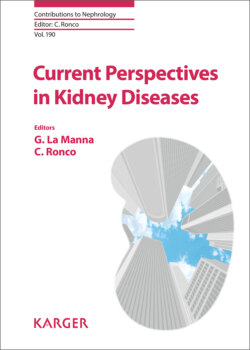Читать книгу Current Perspectives in Kidney Diseases - Группа авторов - Страница 28
На сайте Литреса книга снята с продажи.
Introduction
ОглавлениеContinuous renal replacement therapy (CRRT) is widely used for treating acute kidney injury (AKI). Although there are several experiences on CRRT without anticoagulation [1], some anticoagulation strategy is generally thought to be required to avoid circuit blood clotting. During CRRT, blood is conducted through an extracorporeal circuit, activating coagulation by a complex interaction between patient and circuit. Critically ill patients may also develop a procoagulant state frequently due to sepsis; activation of the coagulation system is triggered by proinflammatory cytokines that enhance the expression of tissue factor on activated mononuclear and endothelial cells and simultaneously downregulate natural anticoagulants, thus initiating thrombin generation, subsequent activation of platelets, and inhibition of fibrinolysis. The beginning of clotting in the extracorporeal circuit has traditionally been attributed to contact activation of the intrinsic coagulation system. However, the bioincompatibility reaction is more complex and is incompletely understood. The activation of tissue factor, leucocytes, and platelets plays an additional role [2].
In spite of the high bleeding risk related to AKI itself [3], systemic anticoagulation with unfractioned heparin has historically been used to maintain the patency of the extracorporeal circuit for CRRT. However, a high incidence of hemorrhagic complications has been documented with wide variability (5–30%) related to differences in patient populations and anticoagulation protocols [4]. Furthermore, a kind of “inverse correlation” between the hemorrhagic risk for the patient and the coagulation risk for the circuit was established in 1996 by Wetering. The higher the attention given to avoid the risk of bleeding (by reducing heparin), the higher is the incidence of thrombotic events to the extracorporeal circuit, and vice versa [5].
To avoid this drawback, both prostaglandin E1 and prostaglandin I2 have been tested in CRRT, but their high cost and hypotension due to vasodilatation are distinct limits to their routine use [2]. Regional citrate anticoagulation (RCA) offers an attractive alternative, and the 2012 Kidney Disease Improving Global Outcomes Clinical Practice Guidelines for AKI recommend the use of RCA as the preferred anticoagulation modality for CRRT in patients without contraindications for citrate, even in the absence of increased bleeding risk or impaired coagulation [6].
